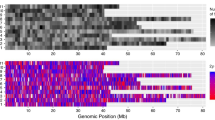Summary
Elite, adapted germplasm is not likely to contain all the favorable alleles available in a species. Three statistics were evaluated for screening populations for their ability to contribute favorable dominant alleles not available in an elite single cross: (1) a statistic proposed by Dudley (SD)=[(P x I1-I1)(I1 x I2-I2)-(P x I2-I2) (I1 x I2-I1)]/[2(I1-I2)]; (2) the upper bound minimum (P x I1-I1, P x I2-I2) ; and (3) the testcross to the single cross [TC(SC)]=P x (I1 x I2), where P is the population to be evaluated and I1 and I2 are homozygous parents of the elite single cross I1×I2. A superiority measure for a population was defined as the product of frequencies of favorable alleles and effects summed over loci where I1×I2 is homozygous unfavorable. Of the statistics considered, TC (SC) should have the highest genetic correlation with the superiority measure under the assumptions made, require the fewest testing resources and have the smallest standard error. Methods considered for screening inbreds were: (1) SDI proposed by Dudley=[(I1 x IW)+(I2 x IW)-I1-I2-IW-(I1 x I2)]/4 ; (2) TC(SC)=IW x (I1 xI2); and (3) UBND=minimum where Iw is the inbred to be evaluated. The superiority measure of an inbred Iw was defined as the relative number of loci where I1 and I2 are unfavorable and Iw is favorable. The genetic correlation with the superiority measure should be highest for SDI. The larger number of measurements used in calculation, the necessity of evaluating potentially unadapted inbreds and larger testing resources required for SDI suggest further research should be done to evaluate these statistics.
Similar content being viewed by others
References
Beyer WH (1968) Handbook of tables for probability and statistics, 2nd edn. CRC Press, Boca Raton, Florida, 642 pp
Brown, WL (1965) Performance and quality in cereals as influenced by genotype and environment. In: Irving GW Jr, Hoover SR (eds) Food quality: effects of production, practices and processing. Am Assoc Adv Sci Publ 77. Washington/DC, pp 38–98
Brown WL (1983) Genetic diversity and genetic vulnerability — an appraisal. Econ Bot 37: 4–12
Burton GW, Davies WE (1984) Handling germplasm of crosspollinated forage crops. In: Holden JHW, Williams JT (eds) Crop genetic resources: conservation and evaluation. Allen and Unwin, London, pp 180–190
Busch RH, Janke JC, Frohberg RC (1974) Evaluation of crosses among high and low yielding parents of spring wheat (Triticum aestivum L.) and bulk prediction of line performance. Crop Sci 14: 47–50
Comstock RE, Robinson HF (1948) The components of genetic variance in populations of biparental progenies and their use in estimating the average degree of dominance. Biometrics 4: 254–266
Dudley JW (1984a) A method of identifying lines for use in improving parents of a single cross. Crop Sci 24: 355–357
Dudley JW (1984b) A method for identifying populations containing favorable alleles not present in elite germplasm. Crop Sci 24: 1053–1054
Duvick DN (1981) Genetic diversity in corn improvement. Proc Annu Corn Sorghum Industry Res Conf 36: 48–60
Eberhart SA (1971) Regional maize diallels with US and semiexotic varieties. Crop Sci 11: 911–914
Frey KJ (1983) Genes from wild relatives for improving plants. In: Yap TC, Graham KM, Sukaimi J (eds) Crop improvement research. Proc 4th Int Congr Soc Adv Breed Res Asia Oceania (SABRAO). Bangi, Selangor, Malaysia, pp 1–20
Goodman MM (1985) Exotic maize germplasm: status, prospects, and remedies. Iowa State J Res 59: 497–528
Green JM (1948) Inheritance of combining ability in maize hybrids. J Am Soc Agron 40: 58–63
Hallauer AR, Miranda JB Fo (1981) Quantitative genetics in maize breeding. Iowa State University Press, Ames, Iowa, 468 pp
Harlan JR (1976) Genetic resources in wild relatives of crops. Crop Sci 16: 329–333
Harlan JR (1984) Evaluation of wild relatives of crop plants. In: Holden JHW, Williams JT (eds) Crop genetic resources: conservation and evaluation. Allen and Unwin, London, pp 212–222
Hayes HK, Johnson IJ (1939) The breeding of improved selfed lines of corn. J Am Soc Agron 31: 710–724
Josephson LM (1982) Development and utilization of populations in maize breeding. Proc 5th South African Maize Breed Symp, Publ 5. Department of Agriculture and Fisheries, Pietermaritzburg, South Africa, pp 22–24
Kramer HH, Ullstrup AJ (1959) Preliminary evaluations of exotic maize germ plasm. Agron J 51: 687–689
Lonnquist JH, Gardner CO (1961) Heterosis in intervarietal crosses in maize and its implication in breeding procedures. Crop Sci 1: 179–183
Plucknett DL, Smith NJH, Williams JT, Anishetty NM (1983) Crop germplasm conservation and developing countries. Science 220: 163–169
Spencer J (1980) Evaluation of tropical germ plasm. Proc 4th South African Maize Breed Symp, Tech Commun 172. Department of Agriculture and Fisheries, Pietermaritzburg, South Africa, pp 20–35
Stuber CW (1978) Exotic sources for broadening genetic diversity in corn breeding programs. Proc Annu Corn Sorghum Res Conf 33: 34–47
Author information
Authors and Affiliations
Additional information
Communicated by A. Hallauer
Joint contribution: USDA-ARS and Journal Paper No. J-12420 of the Iowa Agric. and Home Econ. Exp. Stn., Ames, IA 50011. Project No. 2778. Part of a dissertation submitted by senior author in partial fulfillment of PhD requirements
Rights and permissions
About this article
Cite this article
Gerloff, J.E., Smith, O.S. Choice of method for identifying germplasm with superior alleles. Theoret. Appl. Genetics 76, 209–216 (1988). https://doi.org/10.1007/BF00257848
Received:
Accepted:
Issue Date:
DOI: https://doi.org/10.1007/BF00257848




